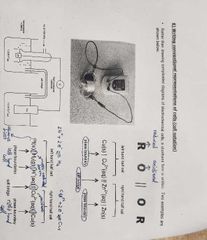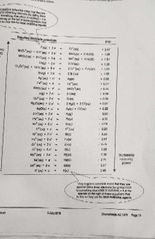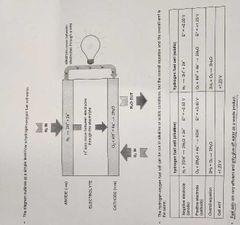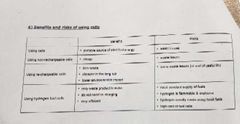![]()
![]()
![]()
Use LEFT and RIGHT arrow keys to navigate between flashcards;
Use UP and DOWN arrow keys to flip the card;
H to show hint;
A reads text to speech;
28 Cards in this Set
- Front
- Back
|
How is an equilibrium set up |
When a piece of metal is dipped into a solution of its metal ions |
|
|
What happens if the equilibrium lies to the left |
-the metal has a negative charge - due to a build up of electrons on the metal |
|
|
What happens if the equilibrium lies to the right |
-the metal has a positive charge - electrons are used up to form metal from the metal ions |
|
|
What does the position of equilibrium depend on |
The type of metal |
|
|
What is a half cell/electrode |
A metal dipping into a solution of its ions |
|
|
Describe metal electrodes |
Consist of a metal surrounded by a solution of its ions |
|
|
Describe gas electrodes |
-this is for a gas and a solution of its ions - here an inert metal is the electrode to allow the flow of electrons |
|
|
Describe redox electrodes |
-this is for two different ions of the same element -where the two types are present in solution with an inert metal electrode to allow the flow of electrons |
|
|
How can we measure potential of an electrode |
To measure it has to be connected to another half cell of a known potential and the potential difference between the 2 measured |
|
|
What does combining two half cells together produce |
Electrochemical cell |
|
|
describe the standard hydrogen electrode |
before the potential can be measured a potential had to be assigned to one particular half cell the elctrode chosen was the standard hydrogen electrode (SHE) and this electrode is assigned the potential of 0 volts the SHE is known as the primary standard as it is the potentila to wich all the others are measured |
|
|
how do you set up an electrochemical cell |
-the two half cells are joined to give a complete circuit the two metals are joined with a wire -the two solutions are joined with a salt bridge -a voltmeter is often included in the circuit to allow the potential difference to be measured. |
|
|
what is a salt bridge |
either a piece of filter paper soaked with a solution of unreactive ions or a tube containig unreactive ions in an agar gel compounds such as KNo3 are often used in salt bridge as K+ and NO3 ions are quite unreactive |
|
|
describe the standard conditions |
cell concentration= 1.0 mol dm-3 of the ions involved in a half equation cell temperature=298 K cell pressure=100kPa the potential should also be measured under zero current conditions a standard potential is written as E⁰ |
|
|
what is the standard hydrogen electrode |
cell notation= Pt/H2/H+ |
|
|
how do you write conventional representations of cells |

the actual solid electrodes are written at two ends if there is no solid in the half equation then a piece of platinum is used the most pxidised spesies are near the salt bridge in the middle the more positive electrodegoes on theright hand side except for te standard hydrogen electrode the the left hand side |
|
|
how to measure the E verses the SHE |
emf = E right - E left a negative value wont work as electrons flow in the right direction |
|
|
what is the secondary standard |
the SHE is difficult to use so often different standard is used which is easier to use the other standards are calibrated against the SHE |
|
|
describe the redox process |
-metal atoms lose electrons at the one electrodemaking the electode negative |
|
|
what is the chemical series |

a list of electrode potentials in order of decreasing potential |
|
|
what is the golden rule |
when two half equations are out together the one with the more positive electrodegets the electrons |
|
|
what reaction takes place whrn the cl2/cl- half cell is joined to the Br2/Br- half cell. explain why this happens |
cl2 2e- <----> 2cl E=1.36 v Br2 + 2e- <----> 2 Br E= 1.09 v cl2 more postive than Br2 so goes forwards and Br goes backwards cl2 + 2Br- ---> 2Cl- + Br2 this hapens as E (cl2/cl-) is more postive than E (Br2/Br-) and so Cl2 gains electrons |
|
|
describe non rechargeble cells |
in these cell the chemicals are used over time and the emf drops. once one or more of these chemicals have been used up the cell is flat and the emf is 0 volts these cells cannot be recharged and have to be disposed of after their single use. |
|
|
describe rechargeable cells |
in rechargeable cells the reactions are reversible- they are reversed by applying an external current that regenerates the chemicals they are used in phones,laptops,tablets,cameras the recharge reaction is the same as the discharge reaction just the other way around discharge equation= LiCoO2 <--->Li + CoO2 recharge equation = Li + CoO2 <----> LiCoO2 |
|
|
describe lead acid |
made up of six cells and used in cars |
|
|
describe fuel cells |
they have a continuous supply of chemicals and so neither run out of chemicals nor need recharging the most common fuel cell is the hydrogen oxygen fuel cell they are very efficient and only give off water as a waste product |
|
|
how do hydrogen - oxygen fuels cells work |

this cell can be run in alkaline and acidic conditions but overall the equations are the same |
|
|
what are the risk and benefits of using cells |

|

